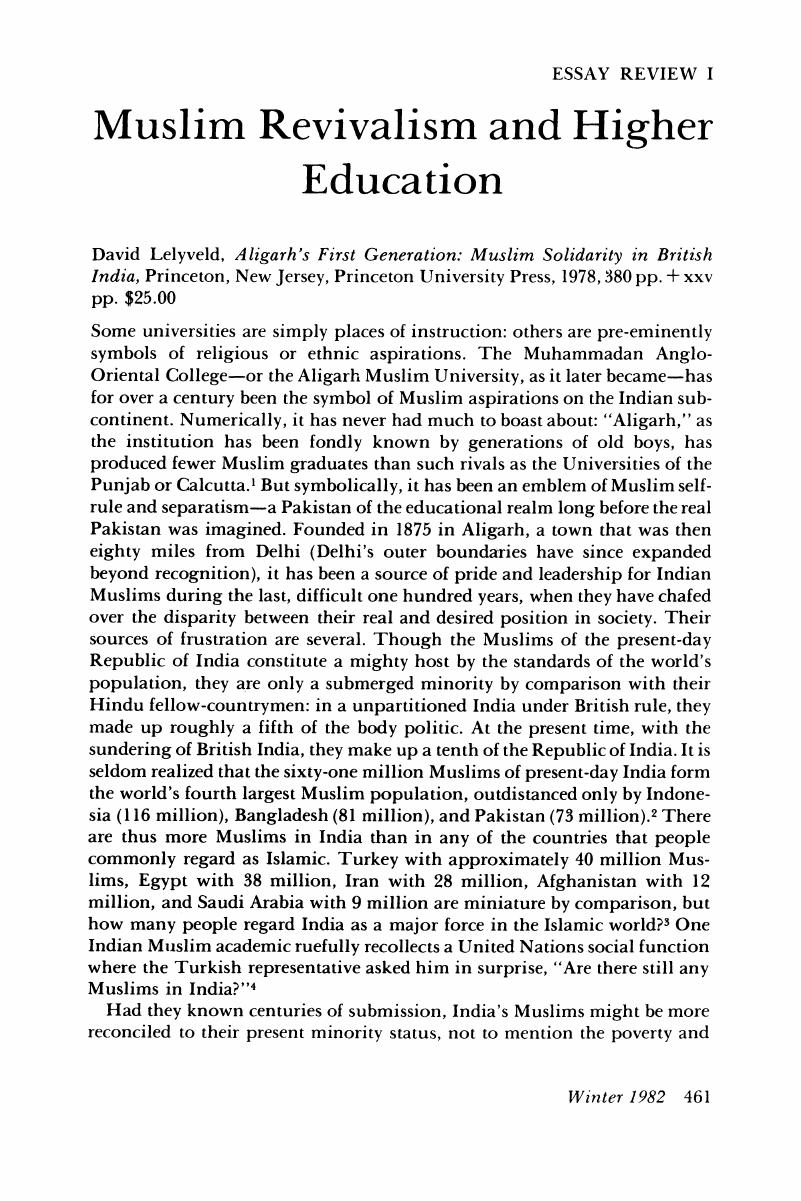No CrossRef data available.
Published online by Cambridge University Press: 24 February 2017

For their comments on an earlier version of this essay review, I am grateful to Professor Sheila McDonough of Concordia University, Montreal, Professor William A. Graham, Jr., of Harvard University and Professor Hatim M. Halibi of the University of Massachusetts, Boston. The system of transliteration used is based on that used in The Muslims of British India (Cambridge, 1972) by Hardy, Peter, which is in turn founded on that adopted in 1895 by the Royal Asiatic Society. The one major exception is the use of the form “sayyid” rather than “saiyid,” because it is more generally recognizable.Google Scholar
1. Applies to the period 1882 to 1902. Note that between 1882 and 1887, the Muhammadan Anglo-Oriental College at Aligarh was affiliated with the University of Calcutta, making it during this brief while a component rather than a rival of it. Lelyveld, David, Aligarh's First Generation: Muslim Solidarity in British India (Princeton, 1978), p. 185.Google Scholar
2. Government of India, India: A Reference Manual (New Delhi, 1980), p. 9; Foreign and Commonwealth Office, A Yearbook of the [British] Commonwealth, 1979 (London, 1979), p. 276; Whitaker, Joseph, An Almanack… 1980 (London, 1979), pp. 202–3; The New Encyclopedia Britannica (Chicago, 1980), IX, 466.Google Scholar
3. Whitaker, , An Almanack… 1980, pp. 202–3.Google Scholar
4. Mujeeb, M., Islamic Influence on Indian Society (Delhi, 1972), p. 193.Google Scholar
5. Bhatnagar, S. K., History of the M.A.O. College, Aligarh (Bombay, 1969), p. 355.Google Scholar
6. Malik, Hafeez, Moslem Nationalism in India and Pakistan (Washington, D.C., 1963), p. 213.Google Scholar
7. Government of India, Report of the Census of British India taken on the 17th February 1881 (London, 1883), I, p. 26.Google Scholar
8. Weinraub, Bernard, “Indian Muslims' Anger Mirrored in Closing of College,” New York Times, April 24. 1973, p. 2.Google Scholar
9. Lelyveld, , Aligarh's First Generation, p. 341; Ali, Maulana Mohamed, My Life a Fragment: An Autobiographical Sketch, ed. Ibal, Afzal (Lahore, 1946), pp. 31–5.Google Scholar
10. Ibid., p. 324.Google Scholar
11. I am indebted for this point to Professor Hatim M. Halibi.Google Scholar
12. Lelyveld, , Aligarh's First Generation, pp. 183–4.Google Scholar
13. Ibid., p. 181; Bhatnagar, , History of the M.A.O. College, p. 134.Google Scholar
14. Hardy, Peter, The Muslims of British India (Cambridge, 1972), p. 103.Google Scholar
15. For a perceptive discussion of Sayyid Ahmad's career and thought, see McDonough, Sheila, The Authority of the Past: A Study of Three Muslim Modernists (Chambersburg, Penn., 1970), pp. 4–15; see also Malik, Hafeez, Sir Sayyid Ahmad Ichan and Muslim Modernization in India and Pakistan (New York, 1980), especially pp. 173–228.Google Scholar
16. Lelyveld, , Aligarh's First Generation, p. 80.Google Scholar
17. The observer was Marshal Lyautey (1854–1934) quoted in Hardy, , Muslims, p. 176.Google Scholar
18. Bhatnagar, , History of the M.A.O. College, p. 238.Google Scholar
19. Ahmad, Aziz, “Sayyid Ahmad Khān, Jamāl al-dīn al-Afghānī and Muslim India,” Studia Islamica 13 (1960), p. 59.Google Scholar
20. Hourani, Albert, Arabic Thought in the Liberal Age, 1789–1939 (London, 1962), pp. 112–4.Google Scholar
21. Keddie, Nikki R., Sayyid Jamal al-Din “al-Afghani”: A Political Biography (Berkeley, 1972), pp. 157–8, 167–80.Google Scholar
22. For a portrait of al-Afghani as a crypto-atheist who secretly wished to subvert Islam, see Kedourie, Elie, Afghani and 'Abduh: An Essay on Religious Unbelief and Political Activism in Modern Islam (London, 1966), pp. 45–6, 63. Hourani in his already cited study of Arabic thought depicts him as a sincerely religious, if idiosyncratic thinker. Perhaps the most balanced and full assessment is that of Keddie (see above).Google Scholar
23. Hardy, , Muslims, p. 127.Google Scholar
24. Lelyveld, , Aligarh's First Generation, p. 310.Google Scholar
25. Hardy, , Muslims, p. 131.Google Scholar
26. These strictures actually referred to the delegates of 1885–1887, but Sayyid Ahmad Khan almost certainly felt the same about the slightly later group. Ahmad Khan, Sayyid Sir, “Speech delivered at Meerut on March 16, 1888” in Zaidi, , ed., Evolution of Muslim Political Thought, I, p. 49.Google Scholar
27. Minault, Gail and Lelyveld, David, “The Campaign for a Muslim University, 1898–1920”, Modern Asian Studies 8 (1974), pp. 163–4, 178–9, 184–5.Google Scholar
28. Meston, Lord in a letter dated 25 March 1915 quoted in Hardy, , Muslims, p. 186.Google Scholar
29. Bhatnagar, , History of the M.A.O. College, p. 312–3.Google Scholar
30. Minault, and Lelyveld, , “The Campaign”, op. cit., p. 178n.Google Scholar
31. A futile attempt was made to re-orientate it toward a defense of the holy places in Arabia, but the life had gone out of the movement. Hardy, , Muslims, p. 197.Google Scholar
32. See Imam, Zafar, “Some Aspects of the Social Structure of the Muslim Community in India” in Imam, Zafar, ed., Muslims in India (New Delhi, 1975), pp. 70–110, esp. pp. 81, 83.Google Scholar
33. Abraham, A.S., “Long March to Maharashtra”, The Times Higher Education Supplement, Jan. 11. 1980, No. 377, p. 6.Google Scholar
34. “Pig in a Tinderbox”, The Economist, August 23. 1980, pp. 30, 33.Google Scholar
35. Ibid.; Weinraub, , “Indian Moslems' Anger”, p. 2.Google Scholar